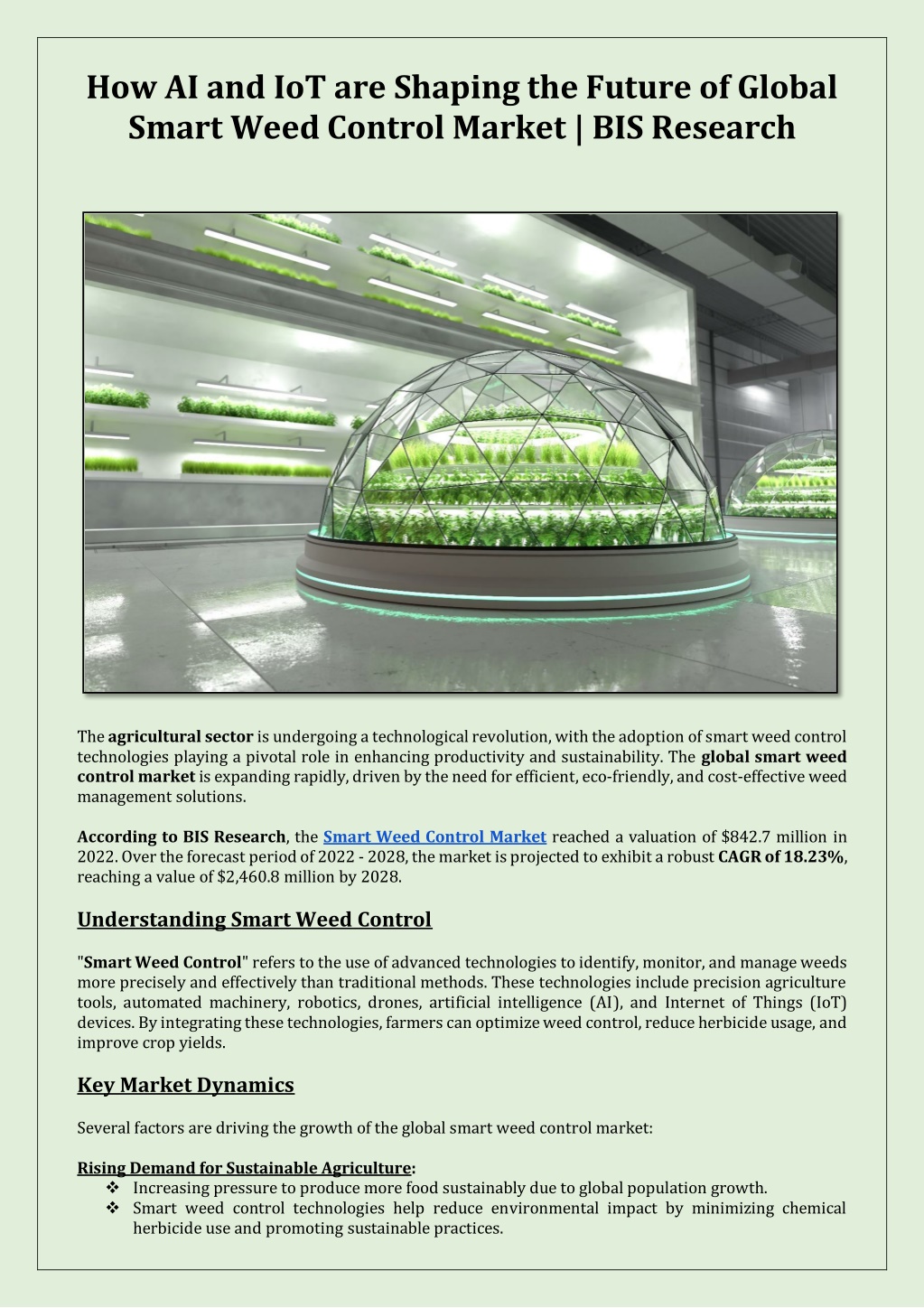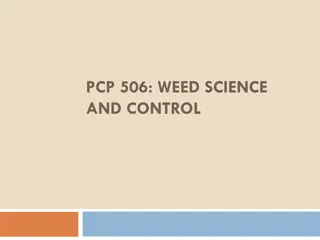
How AI and IoT are Shaping the Future of Global Smart Weed Control Market
The Global Smart Weed Control Market reached a valuation of $842.7 million in 2022. Over the forecast period of 2022 - 2028, the market is projected to exhibit a robust CAGR of 18.23%, reaching a value of $2,460.8 million by 2028.
- Smart Weed Control Market
- Smart Weed Control Market Report
- Smart Weed Control Industry
- Smart Weed Control Industry Analysis
- Agriculture
- BIS Research
Uploaded on | 0 Views
Download Presentation

Please find below an Image/Link to download the presentation.
The content on the website is provided AS IS for your information and personal use only. It may not be sold, licensed, or shared on other websites without obtaining consent from the author. Download presentation by click this link. If you encounter any issues during the download, it is possible that the publisher has removed the file from their server.
E N D
Presentation Transcript
How AI and IoT are Shaping the Future of Global Smart Weed Control Market | BIS Research The agricultural sector is undergoing a technological revolution, with the adoption of smart weed control technologies playing a pivotal role in enhancing productivity and sustainability. The global smart weed control market is expanding rapidly, driven by the need for efficient, eco-friendly, and cost-effective weed management solutions. According to BIS Research, the Smart Weed Control Market reached a valuation of $842.7 million in 2022. Over the forecast period of 2022 - 2028, the market is projected to exhibit a robust CAGR of 18.23%, reaching a value of $2,460.8 million by 2028. Understanding Smart Weed Control "Smart Weed Control" refers to the use of advanced technologies to identify, monitor, and manage weeds more precisely and effectively than traditional methods. These technologies include precision agriculture tools, automated machinery, robotics, drones, artificial intelligence (AI), and Internet of Things (IoT) devices. By integrating these technologies, farmers can optimize weed control, reduce herbicide usage, and improve crop yields. Key Market Dynamics Several factors are driving the growth of the global smart weed control market: Rising Demand for Sustainable Agriculture: Increasing pressure to produce more food sustainably due to global population growth. Smart weed control technologies help reduce environmental impact by minimizing chemical herbicide use and promoting sustainable practices.
Labor Shortages in Agriculture: Many regions face labor shortages in the agricultural sector. Automated and robotic weed control systems alleviate labor challenges by performing tasks that would otherwise require manual labor, enhancing farming efficiency. Technological Advancements: Continuous advancements in AI, machine learning, robotics, and sensor technology. Enhanced capabilities and affordability of smart weed control systems. Technologies enable more accurate weed identification, targeted herbicide application, and real- time monitoring. Economic Benefits: Significant cost savings for farmers by reducing the need for chemical inputs, labor, and time spent on weed management. Higher crop yields and quality contribute to the economic viability of these technologies. Government Support and Incentives: Governments and agricultural organizations promote precision agriculture and smart farming technologies. Subsidies, grants, and educational programs accelerate the uptake of smart weed control solutions. Get your hands on the Sample Report to stay up-to-date on the latest developments in this Market. Download now: Smart Weed Control Market Research Global Smart Weed Control Industry Segmentation Segmentation by Technology: Robotics and Automation Drones Sensors and IoT Artificial Intelligence (AI) and Machine Learning (ML) Segmentation by Application: Agriculture Crop Farming Horticulture Livestock Farming Non-Agriculture Segmentation by Region: North America South America Europe China U.K. Asia-Pacific Middle East and Africa Future Market Prospects The future of the global smart weed control market looks promising, with several trends likely to shape its trajectory: Expansion of AI and Machine Learning: Enhanced AI algorithms and machine learning models. Improved accuracy and efficiency of weed identification and control strategies.
Integration with Digital Farming Platforms: Increasing integration of smart weed control systems with broader digital farming / agriculture platforms. Offering comprehensive farm management solutions. Sustainability and Environmental Impact: Growing focus on sustainability. Development of eco-friendly weed control technologies. Minimizing chemical usage and promoting soil health. Global Adoption and Scalability: Benefits of smart weed control becoming more apparent. Scaling adoption globally, including in developing regions. Contributing to global food security. Also Read: Global Precision Irrigation Market Conclusion The Global Smart Weed Control Industry is poised for significant growth, driven by the rising demand for sustainable agriculture, labor shortages, technological advancements, economic benefits, and government support. By addressing challenges related to costs, technical expertise, and data security, and leveraging opportunities in precision agriculture, affordable solutions, education, and collaborations, the potential of smart weed control technologies in transforming agriculture can be fully realized.
















































